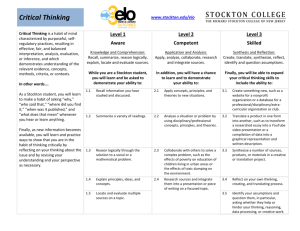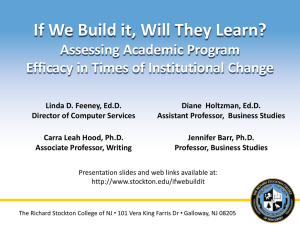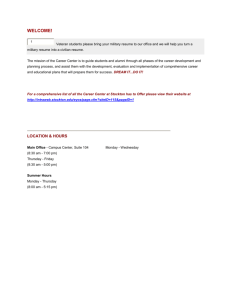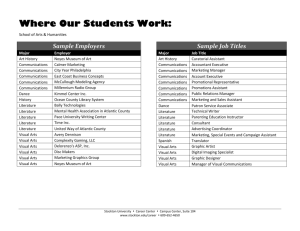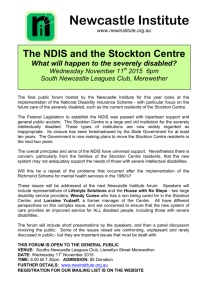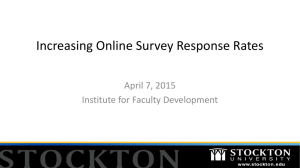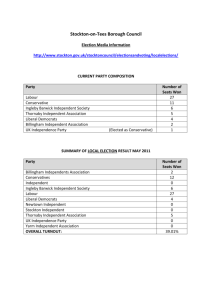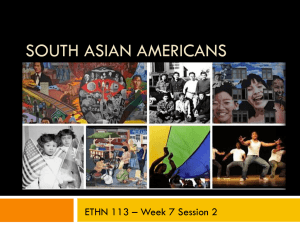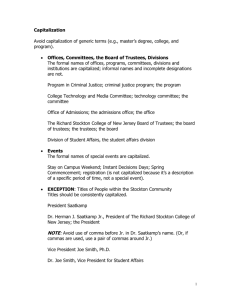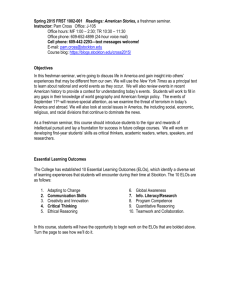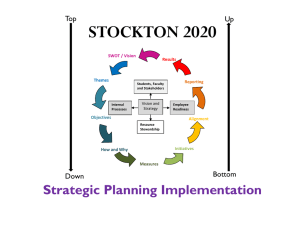Welcome_files/Operating Manual for Stockton School
advertisement
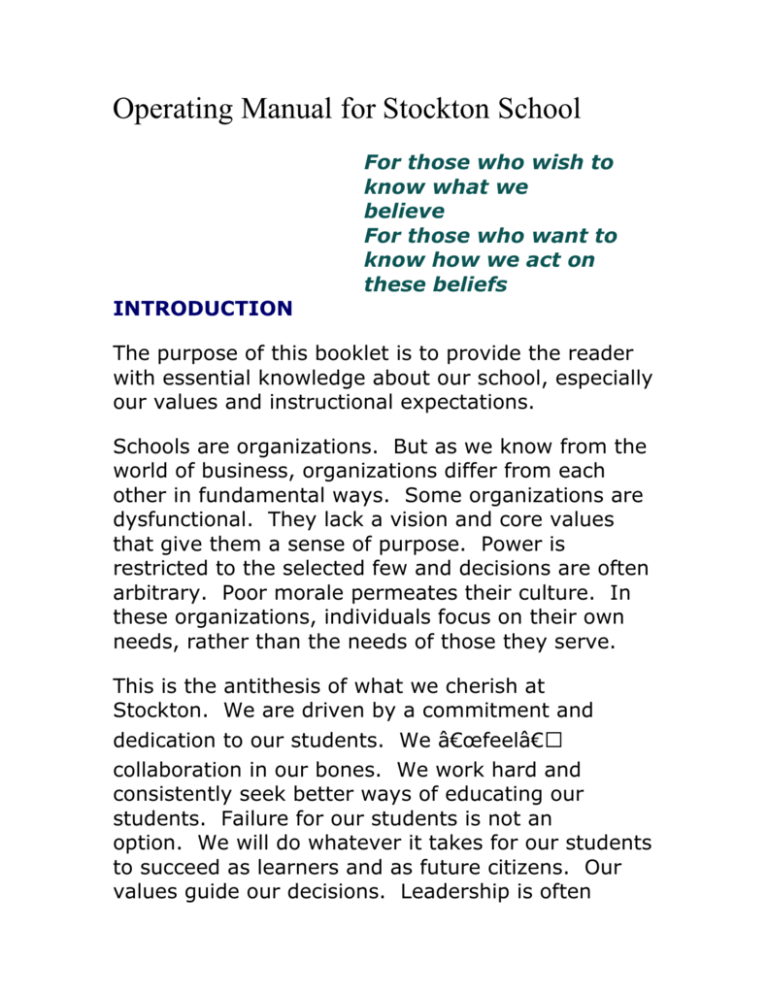
Operating Manual for Stockton School For those who wish to know what we believe For those who want to know how we act on these beliefs INTRODUCTION The purpose of this booklet is to provide the reader with essential knowledge about our school, especially our values and instructional expectations. Schools are organizations. But as we know from the world of business, organizations differ from each other in fundamental ways. Some organizations are dysfunctional. They lack a vision and core values that give them a sense of purpose. Power is restricted to the selected few and decisions are often arbitrary. Poor morale permeates their culture. In these organizations, individuals focus on their own needs, rather than the needs of those they serve. This is the antithesis of what we cherish at Stockton. We are driven by a commitment and dedication to our students. We “feel†collaboration in our bones. We work hard and consistently seek better ways of educating our students. Failure for our students is not an option. We will do whatever it takes for our students to succeed as learners and as future citizens. Our values guide our decisions. Leadership is often based on knowledge and skill, rather than position. Everyone has the opportunity to develop their leadership potential. One of the “little secrets†in schools across the nation is that too often, the instructional programs presented by teachers within the same grade level differ from each other in fundamental ways. In this school, we believe that all students within a grade level should have similar learning experiences that provide the foundation for learning in subsequent grade levels. We have made significant progress in accomplishing this goal through district-wide standards, and through school and grade level collaboration. But reducing this variation of learning experiences is not sufficient by itself. We also want our instructional practices to represent the best thinking about how to teach the curriculum. Providing all of our students with a superior education is our ultimate goal. We want every student to be successful. This document presents key ideas about our school that we believe should be sustained over time. But it also allows for changes to occur based upon new knowledge of organizations and best teaching and learning practices. CORE VALUES We believe that for organizations to achieve their potential; and schools are organizations, a set of core values must guide their actions. At Stockton, these core values are found in our mission statement. They include: • Providing our students with a superior education • Mutual respect among all members of the school community • Collaboration • Caring for each other • Continuous learning for all We try to live these values every day. They are what make our school unique. STANDARDS AND BENCHMARKS The district standards and benchmarks are found in the Essential Curriculum for each content area. Standards are general statements of what students should know and be able to do. Benchmarks are much more specific and they drive our instruction. Unit plans and lessons are derived from them. All activities, materials and assessments are to be aligned with the benchmarks. INSTRUCTION • Make learning meaningful/relevant to students • Assure active engagement of students • Adjust pacing of lessons • Provide Rigor—conceptual understanding, reasoning • Provide for reinforcement • Include Student Reflection • Student/Teacher and Student/Student conferencing • Apply Backward Design • Develop Unit Plans • Use Curriculum Maps • Differentiated Instruction • Plan Lessons using the Principles of Learning • Integration across subject areas • Structure lessons using Workshop Approach • Implement Frontloading • Apply Best practices research • Special Area coordination Workshop Approach Reading • Mini-lessons • Guided Practice • Shared reading • Guided Reading (K to 3) • Independent Reading of “Just Right†books • Focus on strategies • Conferencing • Novel studies • Literature circles (3 to 5) • Reading Response (3 to 5) Writing • The agenda • Mini-lesson • Status of Class • “Try It†• Independent Writing/Conferencing • Reflection • Portfolios Math • Spiral Review/Four Block • Mini-lesson (focus on strategies) • Guided Practice • Independent Work • Reflection/Sharing PROFESSIONAL DEVELOPMENT • Ongoing; directly related to instruction; collaborative; based upon need; research based; best practices • Focused on limited number of goals • Summer Staff Development – each summer grade levels work for approximately ten hours on a specific area of need that was identified during the preceding year. • Instructional Coaching – Reading specialist and math coach support teachers through consultation, model lessons and implementing new strategies and practices. • Teacher-to-Teacher visits – teachers visit each others’ classrooms to learn specific strategies related to instruction, curriculum or classroom management • Team-ups – small groups of teachers meet for half a day to focus on one or two curriculum areas. For example, they may work on developing long range plans for math, reading workshop, phonics instruction. • Collaborative and Common Planning Time – our school schedule allows for one to two times during the week when grade levels, ISS and Math Coach can work together. • Collaboration Plan for Tenured teachers • Lesson Study – Plan, Teach, Assess/Revise/Teach COLLABORATION Collaboration at Stockton is defined as two or more staff members working together on a focused topic. They share, plan and listen to each other. Collaboration permeates our school environment. At times it is formal and at other times informal. Most of our collaborative efforts focus on curricular issues. SPECIAL EDUCATION PROGRAM ▪ Develop IEPs with Child Study Team that best meet each student’s academic, social, and emotional needs ▪ Collaborate with classroom teachers to plan and monitor progress ▪ Use district standards and benchmarks to drive instruction ▪ Provide flexibility in delivery of academic services (in class, pull out, co-teaching, and selfcontained) ▪ Implement modifications to address student needs ▪ Provide small group instruction for remediation according to level of functioning ▪ Use of variety of teaching strategies to accommodate students’ strengths and learning styles ▪ Care and concern for the total development of each child ▪ Teacher knowledge of diverse, research based systematic reading programs ASSESSMENTS • Data is used to drive instruction • Both formative and summative • Integrated into instruction • Students use rubrics to self-assess and develop goals • Schmoker Model – Assess, Set specific goals, Plan, Teach, Re-assess • Multiple measures -- anecdotal records, rubrics, standardized tests, etc. CHARACTER EDUCATION • Character Education Committee • Integrated into classroom subjects/routines • Mutual respect and caring—Adults in school model this behavior with each other and students • Global outreach • Service Club – student volunteers that help the school community and support charities • Stockton Mornings Together—where members of our school share their interests and abilities with each other • Morning Meeting—teachers meet with their students to discuss issues related to how well the class is functioning as a team • Acts of kindness • Daily Character Education Statement As a member of the Stockton Family . . . I am respectful of the rights of others and responsible for my actions. I have the courage stand up for others and for what I believe in each and every day. DISTRIBUTIVE LEADERSHIP • Many opportunities for the staff to demonstrate leadership; presentations; chairpersons of committees; input into school-wide decisions • Leadership Team – comprised of grade level and special area representatives collaboratively plans and discusses ideas related to curriculum, instruction and assessment. Often, the focus is on planning appropriate professional development activities TECHNOLOGY • Make learning vivid • Increase student motivation • Use websites aligned with our curriculum • Laptops and Smartboards infused into instruction • Research specific areas of the curriculum • Conduct virtual tours • Assess data • Enrich the curriculum HOME/SCHOOL CONNECTION • High parent involvement • Parent volunteers • Collaboration with PTA • Support for: Helping Hands; Science Day; Author Day • E-Boards to communicate with our parents and students Some thoughts about our PTA: All of us who work at Stockton express our deep appreciation to the PTA for their generosity to the students and staff of our school. This generosity goes far beyond providing funds for special activities and donations. It is a generosity of spirit—the kind of spirit that says, “We are with you.†We can site many examples of this. But what I am referring to is greater than any specific action. It is a feeling that the PTA is truly our partner in this mission of educating the children in our community.
